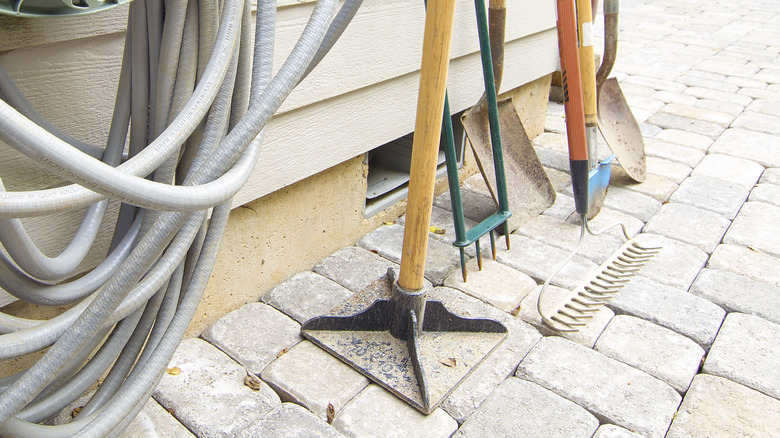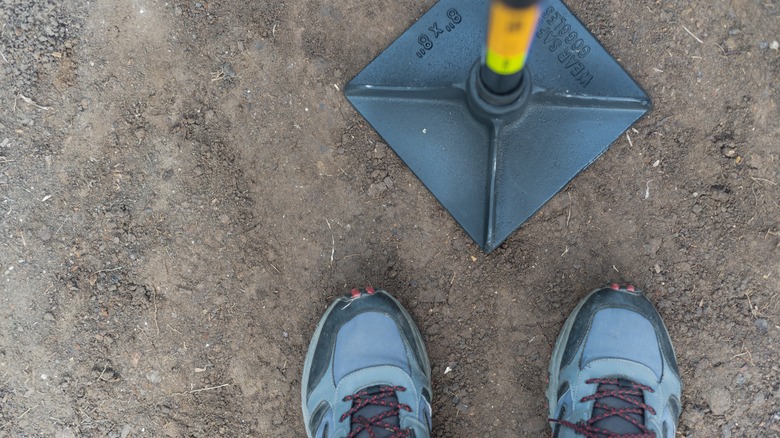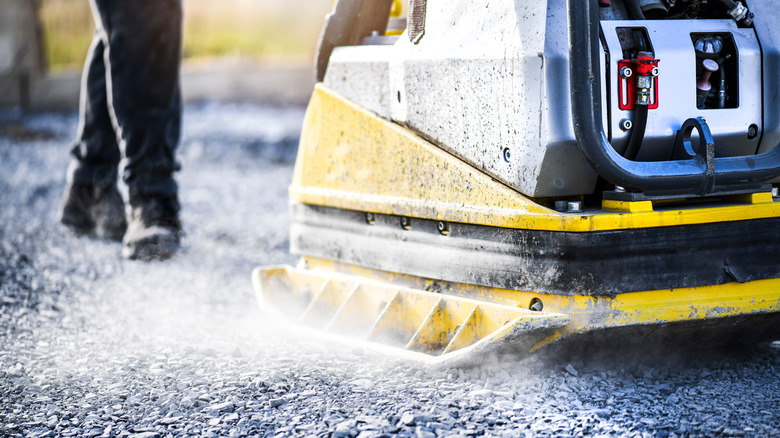What Is A Tamper Tool & How Do You Use One?
We may receive a commission on purchases made from links.
If you ever stroll through Home Depot's gardening tools aisle, you may notice an oddly shaped contraption that consists of nothing more than a flat base and a long handle. This doodad is not some kind of temporary fencing post, nor is it a misshapen hoe. What you're looking at is a tamper — a humble tool with a big mission and plenty of utility around your property and garden. Tamper tools are used to compact loose soil, which is an essential task in construction or if you're doing your own landscaping.
A tamper tool can prove indispensable in a variety of DIY projects. In the garden, you can use it to compact soil you dug up to make trenches or holes for plantings. It can also come in handy when you work on hard landscaping elements, like pavers, driveways, or patches of gravel, where you want to have the underlying soil dense and compact. These tools come in two broadly categorized types — hand-held and powered. One or the other may be more suitable depending on the task at hand. Below, we walk you through the advantages, disadvantages, and common use cases for both hand tamper tools and their powered equivalents.
Where and how to use a hand tamper tool properly
Hand tampers are incredibly useful for small soil compaction jobs around the house and in the garden. These tools generally comprise a flat, rectangular base made of metal and attached to a long pole. The base generally measures up to a foot in length and width. To use the tamper tool, all you do is hold it over the area that needs to be compacted, and strike the ground with the flat base repeatedly. The repeated tapping causes the ground particles to compact, so you get a flatter, denser substrate.
Like all tools, hand tampers come with their pros and cons. Among their greatest advantages is maneuverability. Given their compact dimensions, hand tampers can easily sneak into hard-to-reach places, such as a ditch, or the area between a fence and a nearby tree. This same quality makes this type of tamper tool easy to transport and store. They're also inexpensive. You can buy a sturdy, functional hand tamper, like this one from Home Depot, for under $50. Finally, hand tampers are easy to use even if you're a beginner.
That said, compacting soil with a hand tamper can be an exhausting affair if you need to cover a large area. Just imagine compacting an entire driveway one square foot at a time — it will take forever, and you'll need significant elbow grease to get the job done. If you're compacting large areas, opt for a powered tamper instead of a hand-held one.
When to choose a powered tamper tool over a hand tamper
Powered tampers, which are available as plate compactors and tamping rammers, feature a gas or electric motor that propels the vibration mechanism. This sends waves down to the soil via the compactor's chassis. Upon reaching the soil, these vibrations cause its particles to densify. In the end, you're left with the same result you'd get from a hand tamper. However, the job gets done faster and more efficiently, with less strain on your muscles and joints.
Plate compactors and tamping rammers are not only faster and more efficient at compacting soil; they also do a better job of it. Unlike hand tampers, which are limited in their compacting capacity by your muscle power, these devices have powerful engines that facilitate the process. Thanks to this quality, they can compact soil to a greater depth than their hand-held counterparts.
By compacting the loose layer of soil well, you increase the soil's bearing capacity and make it more suitable to support structures. For instance, soil quality is an important factor to consider if you're building a home addition, and plate compactors afford an easy way to densify a loose substrate before you erect the structure on it. Likewise, these are essential power tools to have if you're building a DIY patio from scratch. Of course, these devices cost more than hand tampers. For example, plate compactors, like this option from Lowe's, can run you a few hundred dollars.


